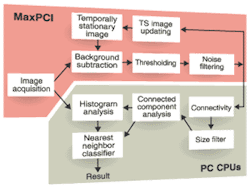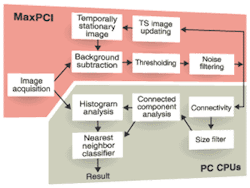Real-time imaging classifies fish stocks
To estimate fish-stock sizes, oceanographers usually take samples of fish eggs at specific places in the ocean. Unfortunately, this method can produce large margins of error if not enough samples are taken during long enough periods.
To overcome this limitation, David Checkley and his colleagues at the Scripps Institution of Oceanography, University of California (San Diego, CA), have developed a real-time flow-imaging and classification system called REFLICS that obtains continuous information on fish-egg abundance as a ship cruises the areas of interest. REFLICS is a real-time machine-vision system that images, processes, and presents an analysis of objects being inspected. During operation, the vision system images small objects in high-speed flow and segments and classifies fish eggs from other objects in real time.
To obtain samples, the vision system uses a submersible pump mounted on the hull of the ship at 3 m below the sea surface. Seawater is pumped at a high rate into a concentrator that separates egg-sized particles from the main water flow. Seawater and eggs then flow through a glass flow cell that is imaged using a 6701AN progressive-scan area camera from Pulnix (Sunnyvale, CA) that provides 60-Hz full-frame acquisition.
"To prevent motion blur, a xenon flashlamp strobe is synchronized to the camera's sync signal. The strobe generates an intense light pulse (20 µs) every 1/60 s to "freeze" the objects in the field of view. A backlighting configuration (brightfield illumination) is used to create a bright background and dark objects," says Checkley.
Video processing must be performed in real time to generate accurate fish-egg counts for users at sea. This means that the imaging module must be processed at 60 frames/s. Accordingly, the vision system uses a dual-processor Intel Pentium II 350-MHz PC with a MaxPCI pipeline-based image-processor card from Datacube (Danvers, MA) to digitize the video and perform low-level image processing. This processing is programmed under Microsoft Windows NT, an operating system that provides a graphical user interface environment, development tools, and support for multiple processors.
After images are captured, the image-processor card performs pipeline image processing so that low-level image-processing functions can be performed in real time. The processed image stream from the image-processor card is transferred to PC main memory, where it is accessible by the PC's two processors. The two processors work in parallel to further process the image stream to count the fish eggs in the video data.
Features that are used to distinguish fish eggs from other objects in the flow are size, shape, and interior features. Since REFLICS needs to segment and classify in real time, segmentation and classification algorithms are used to find and classify regions of interest in the images that could be fish eggs. This is accomplished by performing image-processing functions such as absolute differencing to show moving objects, thresholding to binarize the image into foreground and background pixels, morphological filtering to remove small noise pixels, and grouping foreground pixels to label objects. Checkley's research is funded by the California Sea Grant College Program.

